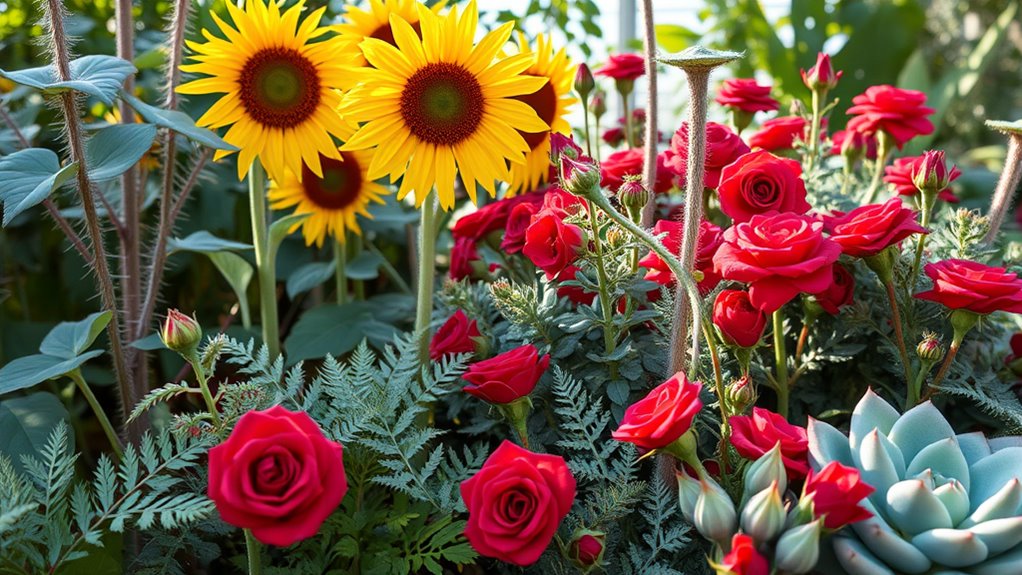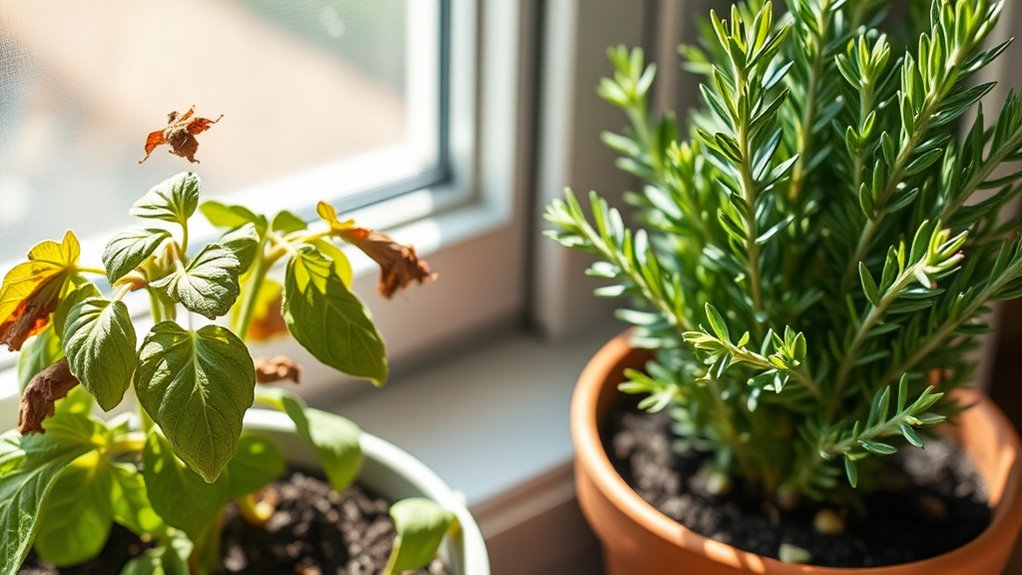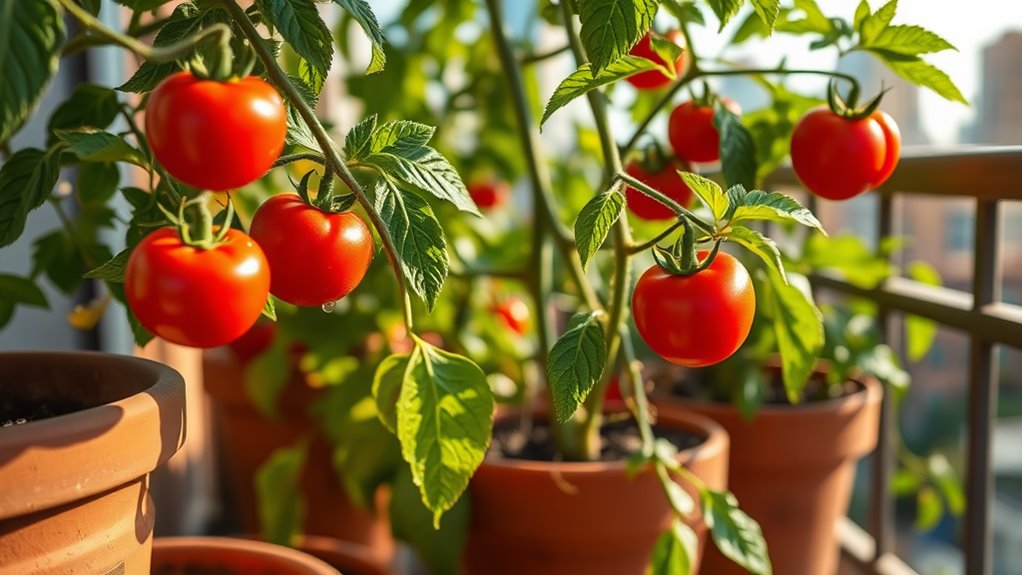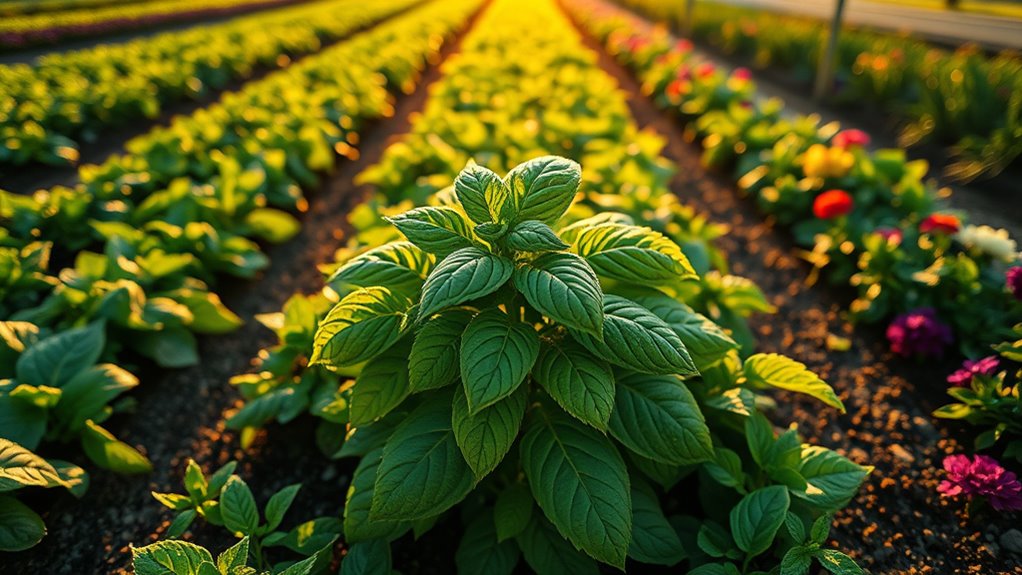This One Trick Keeps My Flowers Blooming Longer Than Ever
You can keep your flowers blooming longer with this simple trick: deadheading. Just snip off spent blooms using sharp shears, cutting right above the nearest leaf node to redirect energy toward new buds and prevent disease. It’s an easy way to promote vibrant growth and extend your garden’s display for weeks. Combine it with proper watering and fertilizing for even better results, and you’ll find more ways to keep your blooms thriving.
Key Takeaways
- Deadhead spent blooms regularly to redirect energy and encourage continuous flowering.
- Prune plants by pinching tips every few weeks to promote bushier growth and extended blooms.
- Fertilize every 4-6 weeks with a balanced N-P-K formula to support robust and longer-lasting flowers.
- Water deeply at the base in the early morning to maintain optimal soil moisture and prevent disease.
- Mulch around plants to retain moisture and nutrients, helping flowers bloom longer.
The Secret Trick for Longer Blooms
If you’re aiming to extend your flowers’ blooming period, deadheading is the essential technique that keeps them vibrant longer.
As a core flower care secret, you regularly remove spent blooms to redirect the plant’s energy from seed production to new growth.
Pinch or snip faded flowers just above the nearest leaf node using clean cuts, promoting vigorous budding on annuals and perennials alike.
This simple habit, done every few days during bloom season, prevents disease and maximizes flower output, ensuring your garden stays colorful and full.
Master this secret for stunning, prolonged displays. In fact, by adopting an efficient routine, like performing deadheading in just one session per week, you can save time while maintaining healthy blooms.
By incorporating deadheading techniques, you can enhance the flowering period and enjoy even more vibrant blooms throughout the season.
Essential Supplies You’ll Need
To keep your flowers thriving after mastering deadheading, you’ll need a few key supplies that make maintenance easier and more effective. For optimal results, incorporate three essential pruning techniques to significantly enhance the growth rate of your garden plants.
These tools help protect plants, enhance care, and extend bloom life without unnecessary hassle.
- Sharp pruning shears for clean, precise cuts that minimize plant stress.
- Durable gardening gloves to shield your hands from thorns and dirt.
- High-quality organic fertilizer to replenish soil nutrients efficiently.
- A reliable watering can with a fine rose for targeted hydration.
- Breathable mulch material to retain moisture and deter pests naturally.
Incorporating pruning techniques into your routine can further optimize plant health and promote even longer-lasting blooms.
Step-by-Step Application Guide
With your essential supplies in hand, begin this step-by-step application guide to effectively maintain your flowers, ensuring each technique builds on the last for optimal growth and longevity.
First, check soil moisture daily; water deeply if it’s dry, using your measured can to avoid overwatering.
Next, deadhead faded blooms promptly to redirect energy, promoting new growth.
Prune leggy stems carefully with sharp shears, shaping plants for better air flow.
Apply fertilizer weekly as directed, mixing it into water for even distribution.
Monitor for pests, removing them manually to keep your flowers thriving longer. By implementing this routine consistently, you’ll unlock the secret to thriving blooms.
To enhance your results, incorporate vibrant blooms by consistently applying these techniques as part of effortless flower bed maintenance.
Adapting for Various Flower Types
Different flower types require tailored adjustments to your care routine, so you’ll need to consider factors like water sensitivity, light preferences, and growth habits for optimal results.
By customizing this trick, you’ll enhance blooming across varieties.
Additionally, by applying the bountiful harvest strategies from vegetable gardening, you can see remarkable improvements in your flowers.
-
Match watering precisely: Use less for drought-resistant succulents to avoid rot, but keep soil moist for thirsty tropicals.
-
Optimize light exposure: Place sun-loving marigolds in full light, while positioning shade-tolerant ferns away from direct rays.
-
Adapt pruning techniques: Trim fast-growing vines frequently to encourage buds, unlike slow bloomers that need minimal cuts.
-
Support growth structures: Stake tall flowers like gladioli to prevent bending, ensuring upright, vibrant displays.
-
Tailor nutrient delivery: Feed high-bloomers more often with balanced formulas, but ease up on low-maintenance types for steady health.
Integrating these care techniques with proper plant selection can help create beautiful flower bed designs that enhance your garden’s overall appeal.
Common Challenges and Fixes
While you’re nurturing your flowers, common challenges like pests, diseases, or environmental stress can arise and impact their vitality.
You spot pests early by checking leaves for bugs; remove them with a strong water spray or apply neem oil to deter infestations. For ongoing prevention, employ natural methods by using easily accessible staples to maintain a balanced garden ecosystem.
For diseases such as fungal spots, prune affected parts and use copper-based fungicides promptly.
If environmental stress from poor soil or extreme weather hits, amend soil with compost for better drainage and mulch to regulate temperature, ensuring your blooms stay robust and vibrant through quick, targeted interventions.
Additionally, watch out for overwatering mistakes, which can lead to wilting and root rot if not managed properly.
Ongoing Maintenance Tips
To keep your flowers thriving, you manage watering frequency by checking soil moisture weekly and adjusting based on weather.
You’ll apply pruning techniques regularly, snipping dead blooms and shaping plants to encourage healthy growth. Incorporate deadheading techniques to promote more abundant blooms.
Finally, set a fertilizing schedule every four to six weeks with a balanced nutrient mix to support robust blooms.
By adopting a specific pruning habit, you can achieve healthier and more abundant plants in your garden.
Watering Frequency
Watering your flowers correctly keeps them healthy and vibrant, so let’s break it down. Frequency depends on factors like plant type, soil, and climate—overwatering leads to root rot, while underwatering causes drooping. Aim for a balance that keeps soil moist but not soggy.
-
Test soil moisture daily; water if the top inch feels dry.
-
Water deeply once or twice a week, depending on weather.
-
Use room-temperature water to avoid shocking roots.
-
Increase frequency during hot spells; reduce in cooler months.
-
Watch for wilting or yellowing leaves as signals to adjust.
Pruning Techniques
Prune your flowers regularly to encourage robust growth, prevent disease, and shape them for optimal beauty.
Use sharp, clean shears for precise cuts just above leaf nodes, promoting vigorous new shoots and abundant blooms. Remove dead or damaged stems immediately to halt potential infections and maintain airflow.
For bushier plants, pinch back tips every few weeks during active growth. Time your pruning to early morning when plants are hydrated, reducing stress.
Observe your flowers closely; if over-pruned, they may weaken, so adjust based on variety and seasonal changes for lasting vibrancy.
Fertilizing Schedule
A balanced fertilizing schedule is essential for your flowers’ ongoing health, providing the nutrients they need to bloom vibrantly. Tailor it to your plants’ needs, using balanced fertilizers to prevent deficiencies and extend blooming.
-
Choose the right fertilizer: Select a balanced N-P-K formula based on your flower’s type, ensuring it matches soil tests for optimal nutrient balance.
-
Set a frequency: Fertilize every 4-6 weeks during growing seasons, but ease off in fall to avoid overwhelming roots.
-
Apply correctly: Dilute liquid fertilizers as instructed and target the soil base, not leaves, to minimize burn risks.
-
Water after application: Always irrigate thoroughly post-fertilizing to help nutrients penetrate and reduce salt buildup.
-
Monitor and adjust: Regularly check for signs like yellowing leaves, then tweak your schedule to maintain vibrant growth.
Maximizing Bloom Longevity
To maximize your flower’s bloom longevity, you’ll implement smart watering strategies that keep soil moist but not soggy, preventing root rot.
Next, apply precise pruning tips to remove dead blooms and encourage new growth without damaging healthy stems.
Finally, add targeted nutrient boosts like balanced fertilizers to fuel vibrant petals and extend their display time.
Watering Strategies
While overwatering can quickly damage your blooms, adopting smart watering strategies ensures your flowers thrive longer by maintaining optimal soil moisture. This means checking soil regularly and watering precisely to avoid root issues and extend bloom life.
-
Always test the top inch of soil with your finger; water only if it’s dry to prevent excess moisture.
-
Water deeply in the early morning to reduce evaporation and ensure roots absorb nutrients effectively.
-
Direct water to the plant base to keep leaves dry and minimize disease risks.
-
Use collected rainwater for its natural pH, avoiding harsh chemicals in tap water.
-
Adjust your schedule based on weather, watering less on rainy days for optimal health.
Pruning Tips
Pruning your flowers properly extends their bloom life and promotes healthier growth. You should deadhead spent blooms regularly to redirect energy toward new buds, using sharp, clean shears to make precise cuts just above a leaf node. This prevents disease and encourages bushier plants.
For perennials, trim back leggy stems in early spring or after flowering to maintain shape and vigor. Always prune during cooler parts of the day to minimize stress.
Monitor your plants weekly; remove any damaged foliage promptly to avoid pests and ensure vibrant, long-lasting displays. With these techniques, you’ll maximize every bloom’s potential.
Nutrient Boosts
Nutrients are essential for keeping your flowers thriving longer, so you’ll boost bloom longevity by selecting the right fertilizers. Choose options rich in phosphorus and potassium to support robust blooms, while balancing nitrogen to prevent excessive foliage growth.
Test your soil first to tailor applications, ensuring plants absorb what they need without waste.
-
Opt for balanced NPK formulas****: Pick 10-10-10 ratios for general health and extended flowering.
-
Incorporate organic amendments****: Use compost or bone meal for slow nutrient release and soil improvement.
-
Apply at key growth stages****: Fertilize in early spring and mid-summer to sustain blooms.
-
Monitor and adjust dosages: Start with half-strength to avoid burning roots, then tweak based on plant response.
-
Combine with mulching: Add organic mulch to retain moisture and gradually release nutrients.





